 |
Alicia Cardenas
When I am working on a problem, I never think about beauty. I only think of how to solve the problem. But, when I have finished, if the solution is not beautiful, I know it is wrong.– Buckminster Fuller
|
This is the first in a series of articles devoted to the ancient practices of tooth modification. To begin this series, I will tell my own story and invite others to share in my experience. Although I believe the history of these practices is important, the evolution of this ritual and its modern day significance plays a huge part in the widespread acceptance of this truly beautiful display of individuality.
I’m not exactly sure when it occurred to me that I wanted to get traditional gold teeth. I just decided it was pretty and divine, and then came to want them for myself. While growing up I remember seeing people with steel or gold caps, and I would assume they had a bad tooth and that was what they put in its place (teeth being one of those things you tend to notice on everyone, and parents pay thousands of dollars to fix in a quest for the perfect American smile). I understood the concept at a young age of “beauty at the price of discomfort,” a theme that would reoccur throughout my adult life. Beautiful straight teeth were something I fought for throughout my youth, regardless of the discomfort. I wanted to be an actress and for that you needed straight teeth. Headgear, headaches, bleeding gums, wax and rubber bands; it was like some sort of torture. Braces were not a sign of beauty, but knowing the end result was beauty, it became widely socially acceptable to have them. After my battle with braces I swore off dentists for life unless completely necessary — little did I know that my tooth saga would continue (and by choice). I would modify my teeth further in search for beauty and for an understanding of the ancient practices of my ancestors.
American culture is so attached to a specific idea of beauty that it is spoon-fed to us on the cover of every magazine, on television, and in the movies. We can’t (or don’t) want to conceive of the different forms of beauty being embraced by neighboring cultures. One great example of this is tooth modification in Mexico — tooth filing, capping, removal, and incrustation are all comonly practiced artforms among the indigenous people of Mesoamerica. In ancient times, these cultures practiced advanced dentistry far beyond what the “savages” were assumed to be capable of.
These people were far from savages, but an advanced culture that excelled at astronomy, mathematics, body modification, and much more. The Maya were the first to apply this adornment and practice it still. Tribes throughout the body of Mexico that came later in history, such as the Toltecs and Mexicahs (Aztecs) followed in their footsteps. While growing up in America, the only people I saw who had gold or steel teeth were the Mexican population (with the exception of people who had very damaged teeth). Since Colorado has such a large Mexican community, I grew up convinced that Mexicans had really bad dental health — little did I know that most gold caps and gold windows being performed in Mexico were inspired by beauty, and not poor dental health!
As I grew older and realized the significance, I became captivated by it. Seeing people with gold teeth began to inspire me to find a deeper, more universal explanation of why this was a healthy part of human history. Modern Mexicans, Mayans, and other indigenous cultures of South and Central America still practice tooth adornment. Mayans can often be identified by their gold caps, usually on the four front teeth (top or bottom). This tradition was so strong that it has survived for thousands of years. If I was going to get my teeth modified it would have to be with the experts. I would travel to Mexico City in search of answers in my quest for tooth modification.
If you go looking in Mexico City for an answer, you will truly find it.
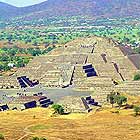 |
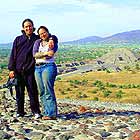 |
Temple of the Moon. |
|
In a population of twenty million there is always something to learn or do. James (the other piercer at Twisted Sol) and I arrived in Mexico City with nothing but our backpacks and a mission of immersion. We had wanted to travel many times together and had never gotten the opportunity, but now found ourselves in our favorite country and the place of our ancestors. Tenochtlitilan. We were greeted and hosted quite possibly by Tonazin Tlalli (mother earth) and Tonatiuh (father sun) themselves — Ana Paula and Ruso. They have a beautiful body art studio called Tonatiuh (cuerpoadornado.com) in Mexico City, and would be our guides and hosts for this ten-day affair. Looking at these two people you are immediately transported into the past — not only do they look like a page out of history, but they live and follow the philosophies of the ancient people. Having guides like these was a blessing. We would see Mexico like we’d never seen it before. Throughout the entire trip teeth were a reoccurring theme. In each museum we visited there were multiple exhibits with tooth incrustations and statues that had teeth that were filed.
 |
 |
Left: With Alfredo and Ana. Right: With Ana and Ruso from Tonatiuh. |
|
While standing out front of the Museo De Anthropologia we ran into four Maya women that all had all front four uppers in gold and gold windows. I explained my fascination and they agreed to allow me to photograph them (in the photo only one of them smiled enough to show her teeth though). Of the four women only one of them needed the gold teeth because of problems with her natural teeth. This concept would present itself again and again, assuring me that my urge to change my teeth was a normal one.
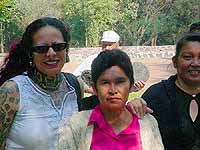 |
With ladies from the Yucatan. |
I had arranged ahead of time to get an appointment with a dentist. Ana warned me that as a board member of the APP, visiting a dentist in Mexico was going to be a hardcore awakening to the realities of cleanliness. I reminded her that the only difference between a dentist in America and one in Mexico is that dentists in America have nicer equipment, but are still just as dirty. I prefered to visit one that had more of a family feel, and had experience with this type of procedure. To my surprise, Ana had an aunt, Pilar, who was a dentist, and I could have an appointment with her. It would require two appointments; possibly three. My first one was to consult with her and really talk about what we were doing. James and Ana helped as I couldn’t understand — my Spanish is very limited and she was using a lot of dental terms.
Pilar was your typical family dentist and was definitely surprised to be asked to perform such an unusual request. Even though it is the style in many rural parts of Mexico and the Yucatan, Pilar was a middle to upper-class city dentist that was more often putting on porcelain caps to fit in with the mainstream, rather than the gold ones which are the style for older generations. She asked why and I told her it was tradition, and she simply mentioned doing incrustations with jewels would take far longer. She also mentioned that it was strange for her to work on perfectly good teeth. I reminded her she was making them better.
I immediately knew when I sat with her that she would be the dentist to do my teeth. I did like the fact that she was a woman. She also seemed to become more and more fascinated with the project as we talked. It was as if she was being reminded that the trade of dentistry was ancient, and she too was carrying on the tradition by performing the procedure. She gave me many opportunities to back out but I became more and more convinced that I was ready to do this, and this was the time to do it.
She began by taking the first and last molds of my teeth and bite — the way they were when I arrived in Mexico. She was very concerned with details and took several impressions to make sure that it was accurate. I must have had a gallon of spit sucked out of my mouth and it was very difficult to hold open my mouth for two hours. She then came at me with a syringe that was much older than I, and numbed only the section of my face necessary to grind down my teeth without pain. She gloved and masked up and ground my teeth down. It took about two hours total. The cleanliness (or lack thereof) only bothered me for the first twenty-five minutes, until I gave in to the experience. Then it was just funny. I am of the strong belief that good intention kills germs*, and in this case it would have to!
|
* Note: in one piercing I go through eight pairs of gloves. Pilar used one pair for two hours, handling everything in the room. I asked James to take photos, but as these things often happen, I had one bag not arrive back in Denver and it was the one with all the film in it… so I have only the photos James took on his camera. |
At the end she fit fake plastic teeth called provisionals over my new stubs. They looked just like oversized teeth except they were only there to protect my stubs from causing me pain from their sensitivity. I would wear the provisionals for three days until my new gold caps where made, having them fall off every time I ate and making me feel like Goofy. The next few days were a surreal period of reflection, as it was too late to turn back, but I was not there yet.
 |
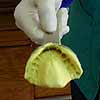 |
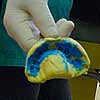 |
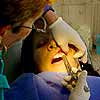 |
Before the operation, making molds, and the ancient syringe. |
|||
The final appointment would be the day before we were scheduled to leave. It was very important that everything went well in getting the gold ones made because I would have to extend my trip if they didn’t fit.
When I arrived back at the office to get my new gold caps I was so excited I felt as if I had been without a part of my body I was about to get back. As she fit them on I knew everything had gone great and I would be able to leave with them in place. Pilar had become obsessed with their perfection and she was worried, not so much if I liked them, but more if she thought they were perfect. In the small amount of time we shared together she was no longer a stranger but like a part of my extended family in Mexico. She would be in my memories as a fine practitioner of an ancient art forever. With some minor adjustments I was reborn. My smile could have not gotten bigger! It would take a few weeks before I stopped tonguing them and wishing I had made more time for an incrustation but eventually I would acclimate. What I could not stop thinking though was how the ancient ones did it and why.
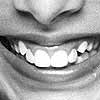 |
 |
 |
Before and After. |
||
The quest for beauty and status was definitely a motivating factor but certainly not the only reason why teeth were modified. In Pre-Columbian Mexico teeth were not only adorned with gold and precious stones (jade, obsidian, hematite, turquoise), but they were filed, stained, notched, and even removed and used in other adornments. Often conch beads were made in the shape of teeth and strung together with jade and coral for large ceremonial necklaces. These items were reserved for royal death offerings. The teeth themselves were a symbol of much more than just physical aesthetics. They symbolized strength and would survive into the afterlife, unlike flesh.
The removal or notching of teeth was done to represent devotion to deities and had special meaning (it was not given out to just anyone). There are many spiritual significances and rituals that surrounded these practices, but when medicine men or shaman performed them, they used virtually the same techniques as are used today — tight fit or cements. However, today if an inlay is done it would require an artificial cap being inlayed and then placed over the tooth (or in place of the tooth), whereas the ancient people did inlays in teeth that were still healthy and attached, making the procedure much more difficult than the one modern dentists usually use.
What I identified most with in these ancient practices was that they were used as a type of medicine to cure a different kind of ailment. For me there was medicine in getting my teeth worked on. It lightened my spirit and brought me a new found love of a once dreaded part of my body. After all the years with braces, my teeth were never perfect, and I often neglected to give teeth-baring smiles. My gold teeth now overshadow any insecurity I ever had about smiling as big as I can. Simply by having them I am setting an example of ancient traditional beauty in modern culture and how adorning teeth is not only about fixing something that is broken, but adding to something making it even better.
My studies have gone on to all continents in search for all the explanations given for this type of bodywork. I have begun to collect and catalog each case of tooth modification done in history and today. I look forward to presenting an article on each continent and the modern day stories of tooth adornment. Thank you to my friends James, Ana, and Ruso for guiding me through this experience. Without them I would have not been able to get them done. Thank you as well to Blake, for planting the seed and helping it grow.

Alicia Cardenas
twistedsoldier at hotmail dot com
 BME/News and Modblog highlight only a small fraction of what BME has to offer. Take our free tour and subscribe to BME for access to over 3 million body modification related photos, videos, and stories.
BME/News and Modblog highlight only a small fraction of what BME has to offer. Take our free tour and subscribe to BME for access to over 3 million body modification related photos, videos, and stories.